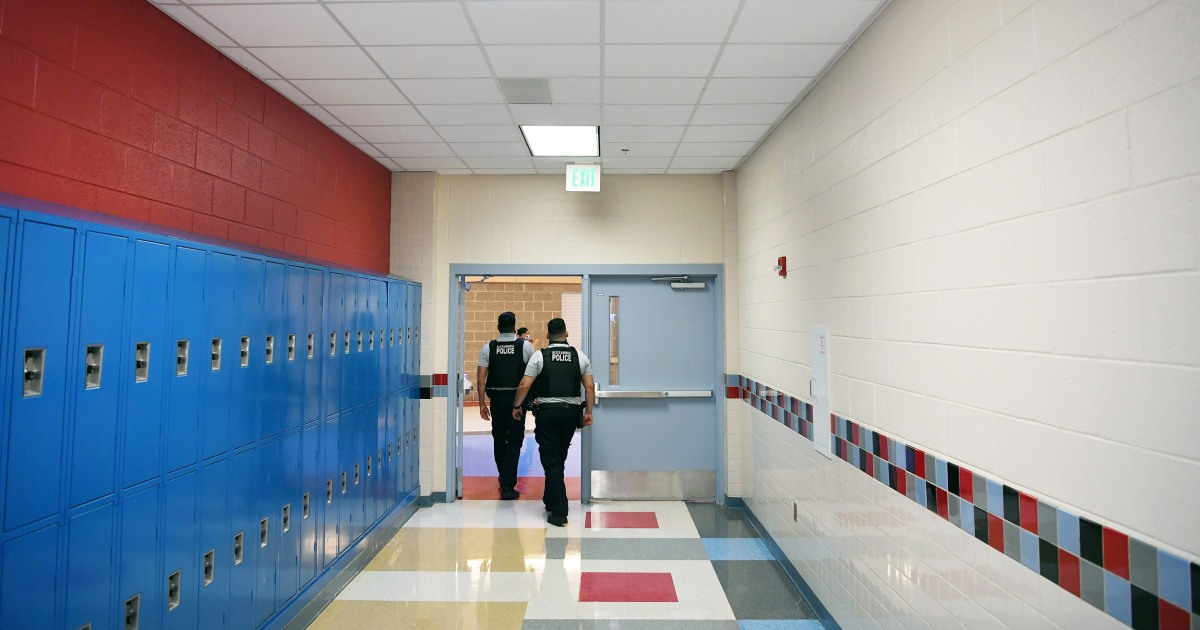
From a young age, Shana Johnson has taught her two teenage boys to be calm with police officers, even with the ones they encounter at school because she knows that Black boys are disproportionately targeted for disciplinary actions and even arrests.
Her children, aged 13 and 17, attend the South Bend public school system in northern Indiana and have told her they often feel intimidated and closely monitored by school resource officers.
“It’s not a positive learning environment for kids to have officers walking around constantly,” said Johnson, who has been researching data on school policing over the last year.
She’s one of several parents and public school teachers who are fighting to convince administrators that police officers should not remain in the South Bend public school system because their presence causes psychological harm to students of color and funnels them into a school to prison pipeline.
Policing in schools continues to be debated across the country in an ongoing racial re-examination, with many districts still struggling with what to do in light of robust data showing the disparate treatment of minority students. Many justice experts say policing has been so deeply intertwined with schooling that parting with the programs can be a hard pill to swallow for districts.
While most cities began posting officers at schools in the 1990s, South Bend has a much deeper history reaching to the 1960s, when officers were put into schools to manage Black children during school desegregation, according to records in the Library of Congress.
The program is deeply entrenched, but the rising momentum of racial accountability after the murder of George Floyd triggered the South Bend Community School Corporation, which oversees 33 public school facilities, to open discussions by sending out a community survey and holding a town hall about the officer program in June. Black students make up 37 percent of the district’s 16,200 students.
Brandon White, the assistant superintendent of the South Bend Community School Corporation, said the efforts were made in response to community calls to remove officers but added that there has also been widespread support for the program, which employs seven officers who patrol four high schools and six middle schools. The program cost the city, the school district and the police department, which shared the expense, over a half-million dollars last year.
White said that the district is not likely to eliminate the program entirely; instead, it is wrestling with how to improve it in light of community concerns.
“We have to be aware of the bias that is represented in some of the decisions that we’ve seen across our country when it involves police interaction with minorities, and so what we can do to make sure that our community does not have those same types of situations is educate our children but also our law enforcement about how to work with our community,” he said.
At least 33 schools districts have ended school resource officer programs, including the Minneapolis, Columbus, Ohio, and Portland, Oregon, districts, while Chicago and Los Angeles have significantly reduced budgets, according to a database compiled by Education Week.
But as the call to remove officers from education settings rises, most districts have decided to keep them and instead are opening up discussions about how to update memorandums of understanding, which guide officers’ conduct.
The New Bedford School District in Massachusetts spent 14 months evaluating its school officer program, even using a nonprofit organization to review it before it decided to keep officers in schools last month.
Twenty miles south of Hartford, Connecticut, Middletown Public Schools created an exploratory committee to review the school resource officer program, which voted 11-2 to keep the program.
Ben Fisher, a professor of criminology and criminal justice at Florida State University who researches school policing, said districts find it difficult to part with police because they are viewed as an extra layer of safety even though there is no objective research to establish that they make schools safer.
“I think we’re seeing that school leaders, policymakers and probably parents, to some extent, have sort of this outsized fear of gun violence in schools, and when they’re crafting policies and practices around issues related to school safety or student behavior or emergency preparedness, there’s this preoccupation with trying to avoid tragedy,” Fisher said.
“Even though we hear about gun violence in schools on nearly a weekly or monthly basis over the last few years, these are still very statistically rare events,” he said. “But they have such emotional salience because they are so tragic that no school leader wants it to happen in their schools.”
Fisher said society views police as a “one size fits all” solution for all sorts of social problems, including issues of mental health, addiction and gangs, without real logic behind it. Putting officers in schools, he said, is symptomatic of that.
According to the School Policing Research to Policy Collaborative, a group of researchers in criminology, juvenile justice and law, “data consistently shows that police presence in schools leads to no change or an increase in reports of serious crime, as well as non-serious crimes,” and that a study of 179 school shootings from 1999 to 2019 found no evidence that school resource officers “lessened the severity of school shooting incidents.”
The presence of security officers has led to unintended consequences, including increases in suspensions, expulsions and referrals to the justice system, particularly for Black and brown youths, said Marc Schindler, executive director of the Justice Policy Institute, a nonprofit national organization that works on juvenile and criminal justice issues.
From 2015 to 2016, students of color were more likely to go to schools with police officers, more likely to be referred to law enforcement and more likely to be arrested at school, according to a report last year that the American Civil Liberties Union compiled from the Education Department’s Civil Rights Data Collection.
In addition, a different study last year found that even when two geographic areas had very similar juvenile arrest rates, officers’ perceptions of “threats” varied vastly between predominantly white schools and predominantly Black schools.
School resource officers, or SROs, in suburban-white districts tended to “view external threats — particularly school shooters — as the most salient threat to school safety, and consistently emphasized the need to protect students from potentially dangerous outsiders,” the study found. “On the contrary, SROs in the urban-diverse district spoke more about students themselves as threats, believing that students had a potential for committing crime and violence that stemmed from their negative family and community environments.”
According to a 2014 South Bend Tribune investigation, school resource officers issued almost 300 tickets to students between 2010 and 2014 for actions such as fighting and smoking that carried fines of more than $100 as well as other consequences like the suspicion of driving privileges. Seventy-four percent of those tickets were given to Black students, even though they make up only one-third of the school district. The South Bend Police said the practice has not been enforced in several years.
Despite the research, the National Association of School Resource Officers says disparate racial treatment is more likely to be due to a lack of adequate training.
South Bend Officer Anthony Pearson Sr., a resource officer in the school district since 2014, said that there are good and bad apples in any profession but that he ultimately believes officers serve not only as positive mentors but also as deterrents for illegal activity. Pearson said that there is also a misunderstanding about how much power officers have and that they have a limited capacity to interfere in school affairs.
“We are there to protect children, and we would give our life for them if there is a threat coming into the building,” he said.
Pearson said he and other resource officers get 40 hours of training to be certified before they are placed in school settings.
But Schindler said no data or research has shown that officer training in racial bias is effective.
Education organizations still widely support the programs, including the Association of Secondary School Principals, which said “specially trained SROs can make positive contributions to the learning environment and serve as educators, mentors, and support figures for students.”
Aaron Kupchik, a professor of sociology and criminal justice at the University of Delaware, said schools are not amenable to eliminating officers because even if their presence does not help students, they benefit other groups.
“They help the police department by giving them eyes and ears on the ground with students and to help socialize young people to trust the police and be informants,” Kupchik said. “They help school administrators because if something does happen, they have a very easy claim that they were doing all they could to prevent it. Many teachers like them, because they feel it’s a helpful security blanket in case they have a student who is threatening and dangerous or brings a weapon. And parents like officers so that their child can be protected from the other students who the parent is afraid of, perhaps.”
Kupchik said that while many officers truly care about children and want to do well by them, on balance, the harms outweigh the good as research has found that the presence of police officers can result in worse school social climates “especially to students of color.”
South Bend public school teacher Regina Williams-Preston has been raising red flags about school policing for the last seven years and was one of the people who spoke out against the program at the town hall meeting in June.
“Police are an authoritarian presence that are about control and compliance, which is not good or healthy for kids, especially for African American kids,” said Williams-Preston, an educator for over two decades who is also a former mayoral candidate.
The South Bend Community School Corporation said it will present the community survey results along with its recommendation for the police program to the school board on August 16, but Williams-Preston said no matter the outcome she’ll continue the fight until all officers are out of the district.
“As a city and as a community, if we talk about our values as being race-conscious and equitable, our actions need to match those values, ” she said. “And keeping police in schools does not match those values.”
Source: | This article originally belongs to Nbcnews.com










